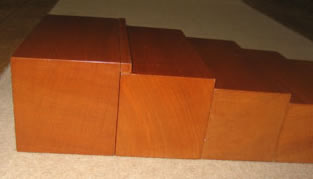|
- 10 brown prisms of the same length (20cm) but differing in height. They vary from 10cm x 10cm x 20cm to 1cm x 1cm x 20cm.
- A floor mat of contrasting color.
Invite the child by telling him you have something to show him. Tell the child that for this lesson, we will need a mat. Have the child fetch and unroll a mat. Bring him over to the correct shelves and point to the Brown Stairs. Tell the child: “These are the Brown Stairs”.
- Show the child how to hold the thinnest prism by gripping over the top of the center part of the prism using your right thumb and fingers.
- Slowly slide the prism off of the shelves until it is fully out.
- Carry the prism vertical and at waist level.
- Have the child carry all of the prisms over one at a time and place them randomly on the right side of the mat. (Show the child to place his hand underneath some of the thicker prisms.)
- Once all of the prisms have been brought over to the mat, have the child stand to your left.
- As you remain standing, carefully pick up the thickest prism (using both hands), and place it near the back left corner of the mat.
- Turn to the child and tell him that you are now looking for a specific one.
- Go over to the right half of the mat and carefully choose the next thickest prism. (Use both hands)
- In a steady and precise movement, place the prism directly under the thickest prism and align them so that they are well aligned.
- Once it has been placed, check to see if it is well aligned by sliding your hand along the left side of the two prisms.
- Continue placing all of the prisms in correct order and placing them so they come closer and closer to you as each is placed.
Dismantle the Brown Stairs by removing the thinnest to the thickest prism and placing them on the right half of the mat.
Invite the child to build the Brown Stairs. To help him get started, ask him which one he is going to start with. If the child seems to understand, you can let him work alone. Once he is done, have him replace the prisms in correct order on the shelves.
The child builds the stairs individually as was shown in the demonstration.
Once the child has seemed to master the building of the stairs, the directress will show him an additional step. The directress will carefully place the thinnest prism on the ledge of the second thickest prism and up against the thickest prism. Show the child that by doing so, the second thickest prism is now at the same height as the thickest. Repeat this on every edge of every prism by working your way down.

Grading from an extreme
Grading from a midpoint
Stereognostic
Matching to the environment
Thick and Thin
The positives, comparatives, and the superlatives
Visual discrimination of dimensions (thickness).
- Refinement of voluntary movement.
- Muscular education of grip.
- Preparation for mathematics.
The control of error lies within the child being able to discriminate the dimensions.
3 to 3 1/2 years
Share your experiences in the
| 
